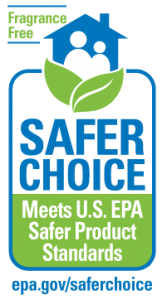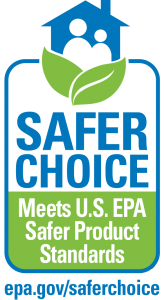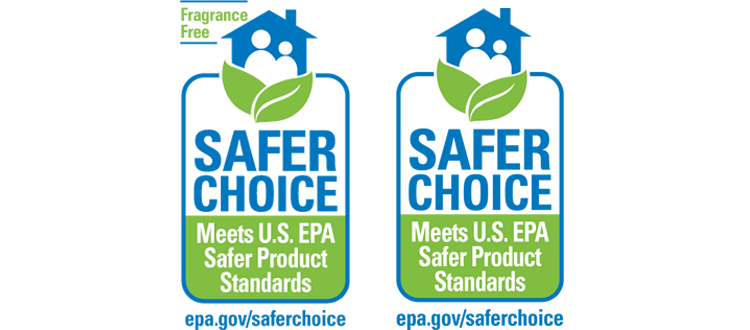Is EPA’s New Labeling Program Really a Safer Choice?
 |
| Jamie McConnell Director of Programs & Policy |
Last week the EPA unveiled the new “Safer Choice” label to be used on cleaning products that meet the criteria of the agency’s Safer Choice Standard (formerly known as Design for the Environment Program, or DfE). The standard includes requirements for packaging, PH levels, performance, use of volatile organic compounds, and ingredient disclosure and safety. According to the Safer Choice website the new label is supposed to indicate to consumers that the product is a safer choice for people and the environment.
Some cleaning products will also carry a “fragrance-free label” that certifies the product does not contain any fragrance chemicals and only contains ingredients on the Safer Choice’s Safer Chemical Ingredients List. This label is particularly helpful for consumers who want to totally avoid all fragrances.

What’s interesting about the two labels is that the Safer Choice standard allows any fragrance ingredients at all. The Safer Choice Standard includes separate criteria for fragrance. Why you ask? Because most fragrance ingredients do not meet the criteria for safer chemical ingredients, so the Safer Choice program developed separate criteria that essentially enabled problem fragrance ingredients to pass.
To further explain, take a look at the Safer Chemical Ingredient List—almost all of the fragrance ingredients listed are rated as “yellow triangles”, which indicates they still pose health hazards, but may be best-in-class for their category (best-in-class meaning there isn’t a safer alternative that’s serves the function of giving scent to a product). The safest ingredients on the Safer Chemical Ingredient list are rated with a “green circle” Of course the program has to allow some best-in-class chemicals for certain essential functions; for example, those functions that enable a product to perform effectively, like a solvent, where there currently may not be safer alternatives.

However, fragrance is not essential to the effective performance of a product, it’s purely to make a product smell good. Considering most of the fragrance ingredients on the Safer Chemicals List have been flagged as an area for safer chemical innovation, with only a few green circles, indicates that fragrance is inherently hazardous. As a result, the Safer Choice label is somewhat misleading, because if the product contains fragrance, it contains chemicals of concern. Consumers who want to buy a product with the Safer Choice label because they are concerned about harmful chemicals should look for the fragrance-free label.
There is no doubt that the EPA’s Safer Choice program helps to incentivize the use of safer and more environmentally friendly cleaning product ingredients, as well as the use of green chemistry to support “informed substitutions” to ensure ingredients that are being substituted are replaced with safer ones, and not ones with a similar hazard profile. However, allowing products that contain fragrance to carry the Safer Choice label undermines the intention of the Safer Choices program to promote products that are safe for human health and the environment.
Bottom line: fragrance should not be allowed in products that carry the Safer Choice label. It’s misleading to consumers and undermines the intention of the program. It also does little to incentivize companies to invest resources into finding safer fragrance alternatives through the use of green chemistry. If you want the reassurance that the product you are using is truly safe for your health and the health of the environment, look for the fragrance-free label. Products carrying the label will hit store shelves this summer.
Note: Women’s Voices for the Earth is a member of Safer Choice’s technical advisory group.




Well said Jamie! I did want to add that EPA states that when fragrances are used, the ingredients are required to be listed on the label, so that people with allergies and those concerned about specific ingredients can avoid those. Obviously, this is no substitute for safer chemicals, but its a start.
Thanks for your comment, Mark! Something to note, the EPA only requires companies to list fragrance allergens, not all fragrance ingredients.
It’s also frustrating that the family of methylisothiazolinone/ benzisothiazolinone/ methylchlorisothiazolinone preservatives earned only a yellow triangle and not a gray square. The latest research in Europe, where MI has been banned in leave-on products and severely restricted in wash-off products, has shown this nasty preservative to be a sensitizing agent to “epidemic” proportions – now affecting approximately 10% of the UK population and likely getting there in the US. Dermatologists that used to see one MI-positive allergy test a year are now seeing one a week. The EPA was notified of the consumer risk last fall and is slowing looking at the situation but hasn’t made a ruling in its classification yet.
You can see the trail of research and growing concern in the scientific community here: https://www.facebook.com/notes/allergy-to-isothiazolinone-methylisothiazolinone-and-chloroisothiazolinone/medical-research-news-coverage/827249720662066